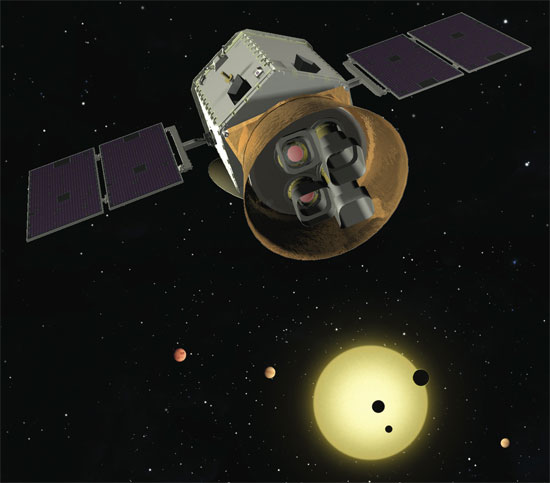NASA funded a million USD for the Tess project
The Satellite Planetary Survey Project (TESS) at MIT is one of 11 recent proposals, which are evaluated as potential future scientific missions, according to the US Space Agency. (NASA).
In this project, George Ricker, principal investigator, and senior research scientist at the Institute of Astrophysics and Kavli Space Research (MKI), MIT. Scientists will use a range of telescopes to survey the entire sky to detect different planets of the planet, including Earth-sized planets to planets. formed from giant air masses, in orbit around the nearest and brightest stars in the sky.

The main goal of Project Tess is to determine the orbits of the planets orbiting stars closest to the earth.
" Tess will conduct a survey of the entire sky, a survey area 400 times larger than any previous survey conducted ," according to Ricker. " The Tess project will help us identify thousands of new planets that follow the trajectories of different types of stars, and the difference in distance between host stars and their satellite stars ."
" We are excited, because the Tess project marks a breakthrough in space science ," said Josh Winn, associate professor of physics, a member of the Ricker team.
Winn added: " The telescope on earth has revealed many details about extraterrestrial planets, from their orbit to the composition and atmosphere. However, these telescopes mainly used to study giant planets, NASA's Kepler astronomical satellite has discovered the existence of many smaller planets but they are quite faint, and difficult to study by astronomical satellites. In the meantime, the Tess project allows easy exploration of large numbers of small planets around the brightest stars in the sky, and the array of many terrestrial telescopes will help the same. when discovered many small planets orbiting a star ".
Tess is one of five projects selected to have the potential of an " adventurer mission ," and will receive $ 1 million in funding to conduct research for 11 months. The members of the project include: Ricker and Winn, along with Jacqueline Hewitt, professor of physics and director of the Institute of Astrophysics and the study of Kavli space, MIT; Sara Seager, physics professor and Ellen Swallow Richards, professor of planetary science, atmosphere and Earth.
At Kavli Institute of Astrophysics and Space Research (MKI), MIT: Scientist Roland Vanderspek and Joel Villasenor act as assistant principal investigators and scientific coordinators, while lead researcher Alan Levine will monitor efforts to design software to support mission implementation.
Participants in the Tess project also include: NASA Goddard Space Flight Center; Orbit Science Research Company; Ames Research Center, NASA; Smithsonian - Harvard Astronomical Center and the Space Telescope Science Institute.
After a detailed study of Tess Project's mission, NASA will select two of the mission proposals for the " Adventurer's Mission " in February 2013. The tasks will then proceed specifically. by flight and some other tasks can be started in 2016.
- NASA's planet hunter finds a black hole ripping apart a star
- Directly viewing the process of SpaceX launching NASA TESS satellite to space
- NASA launches a spacecraft looking for extraterrestrial life
- NASA's new spacecraft begins its mission to explore the world
- South Korea funded $ 35 million to build a general hospital
- More than 200,000 stars appeared in NASA photos
- NASA recruited a new
- NASA launches the satellite to search for the planet TESS
- Strange planetary system has 3 'Venus'
- NASA funded 30 new space research projects
- NASA discovered a 'super Earth' evaporating
- The project funded by Bill Gates predicts that the next pandemic will kill 33 million people in 25 days
 Van Allen's belt and evidence that the Apollo 11 mission to the Moon was myth
Van Allen's belt and evidence that the Apollo 11 mission to the Moon was myth The levels of civilization in the universe (Kardashev scale)
The levels of civilization in the universe (Kardashev scale) Today Mars, the sun and the Earth are aligned
Today Mars, the sun and the Earth are aligned The Amazon owner announced a secret plan to build a space base for thousands of people
The Amazon owner announced a secret plan to build a space base for thousands of people Chilling discovery of cosmic object that almost brought the Earth to 'apocalypse'
Chilling discovery of cosmic object that almost brought the Earth to 'apocalypse'  Admire 7 planets in the Solar System appearing at the same time in the night sky
Admire 7 planets in the Solar System appearing at the same time in the night sky  Does the Solar System have 5 more planets similar to Earth?
Does the Solar System have 5 more planets similar to Earth?  New discovery: 7 Earth-like planets that could be habitable
New discovery: 7 Earth-like planets that could be habitable  6 habitable planets discovered at the same time
6 habitable planets discovered at the same time  Strange Phenomenon: Why Are Planets 'Running Away' From the Sun Despite Their Extremely Strong Gravitational Force?
Strange Phenomenon: Why Are Planets 'Running Away' From the Sun Despite Their Extremely Strong Gravitational Force? 